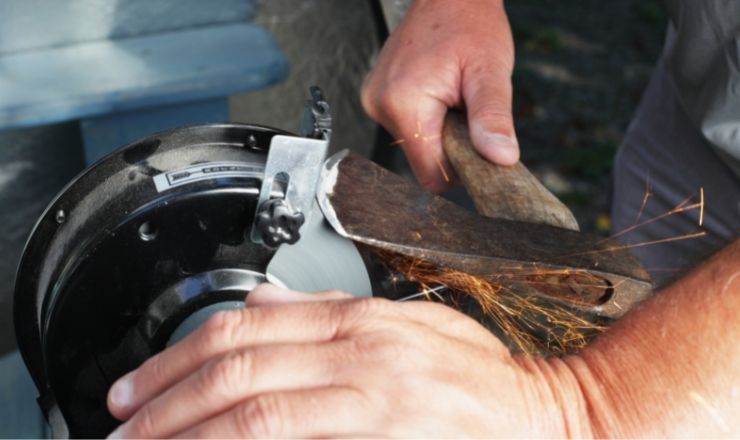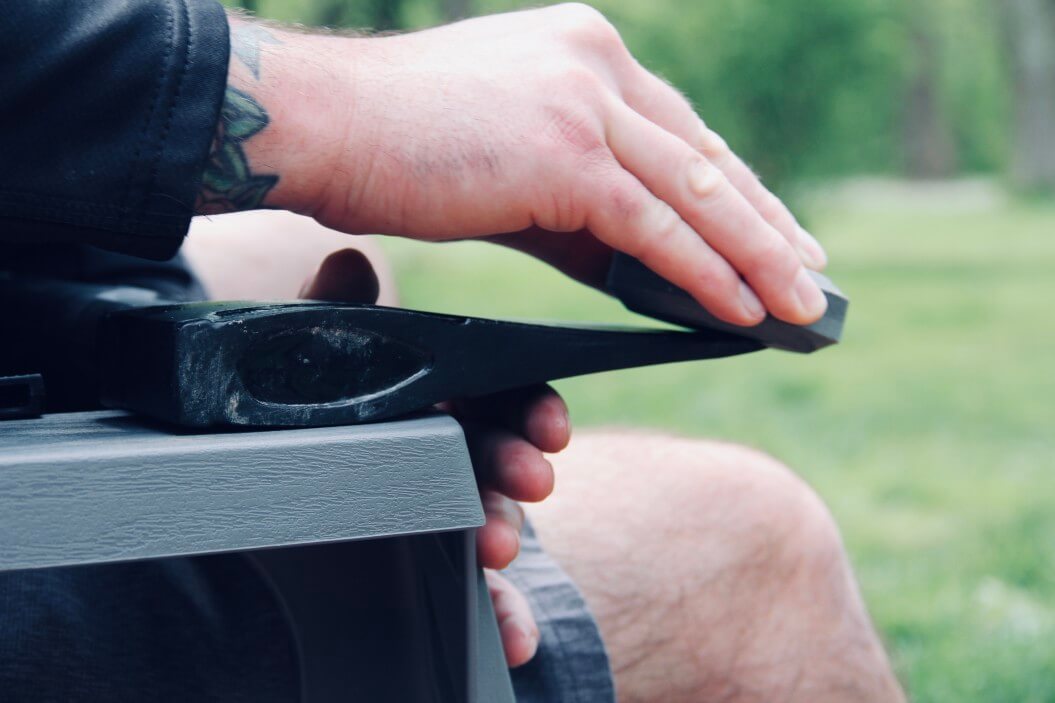A sharp axe blade is like a sharp knife, it’s not just better for cutting, but it’s also safer. For starters, a dull blade just won’t cut as well as a sharp blade, so you’ll likely be spending hours just to cut through one log. This makes you tire out faster, and if you’re felling a tree, that could be dangerous.
The other problem with a dull blade is that if a blade is too dull to even cut with, it’s only going to bounce off of what you’re cutting, coming right back at you, potentially causing serious injuries.
For these reasons, you should always work with a sharpened axe blade. Keep reading to learn how to sharpen an axe blade and how to maintain it going forward, so you can use your trusty axe for years to come.

Making Preparations Before Sharpening An Axe Blade
Before you sharpen an axe, you must make certain preparations including having the right safety gear and sharpening an axe with a clean blade.
Wear gloves and goggles, as well as a dust mask or respirator, if you’re using a power tool to sharpen your axe. These safety precautions are not optional, especially with the use of power tools. Inhaling metal fragments will cause serious issues for your body down the road, so you need to protect yourself.
When you’re sharpening an axe blade, it’s also recommended to place it on a flat surface, or even better, in a vice. If you plan to sharpen an axe with a power tool, the vice is the best way to go, to secure the axe and so that you have both hands available to control whatever tool you’re using.
Cleaning Rust Before Sharpening An Axe Blade
With the safety and prep measures laid in place, your first step to sharpening an axe is to clean the blade of any debris, dirt, and rust. You can do this easily with a piece of rough grit sandpaper or with a rust eraser.
Once you’ve cleaned the dirt, you can remove the rust by applying even pressure to the sandpaper or rust eraser. You can do this by running the sandpaper or rust eraser from the handle to the tip of the blade, applying even pressure throughout the process.
When the rust is gone and your axe is shiny once more, it’s time to start sharpening. As mentioned, make sure your axe is resting on a flat surface or is locked in a vice.
CLOVERHOME BestSponges Rust Eraser

Features:
- The cleaning sponge inner layer is a high density sponge, the outer layer of nano emery process
- Uses for stubborn dirt stains cleaning all kinds of kitchen utensils on the stove, rich crust are good clean stubborn grease rust
- You can use it clean kinds of things, like stainless steel, enamel, stoneware, countertops, crystal, glass, wood, chrome etc
How To Sharpen An Axe With A Sharpening Stone
The first way you can sharpen an axe blade is to use a sharpening stone, also called a whetstone. Like sandpaper, sharpening stones come in different grades to get a certain finish.
Types of Sharpening Stones
Sharpening stones usually come in three grades, including:
Sharpening An Axe Blade With A Whetstone
Before sharpening an axe with a whetstone, you’ll want to first coat it in oil or water to minimize dust or fragments and to moisturize the blade.
After this, start moving the stone in circular motions, remembering to apply the same amount of pressure at all times. Work from end to end of the axe blade, and don’t forget to do both sides of the axe blade.
Keep an eye on the edge, and don’t be afraid to lightly touch it to test sharpness. You don’t have to cut yourself, but lightly tough the blade’s edge to see your progress.

Sharpening an Axe With A Power Tool
Sharpening an axe with power tools is relatively easier and faster than sharpening an axe by hand with a whetstone or file. Again, for this method, it’s best to have a vice to put the axe blade in, for more control over the tool you’re using with both hands.
Dremel Tool
A Dremel is a small, yet powerful little tool that makes sharpening an axe oh so easy! To start, you’ll want to get yourself the right type of Dremel head, like an aluminum oxide grinding stone. If you’re using a Dremel, you should have a pail of water to dip the axe blade in to cool it off.
Like using a whetstone to sharpen an axe, you will move the Dremel along the blade from end to end, using evenly pressured circular motions. Remember to lay the Dremel head flat on the blade, so that you don’t end up taking things too far and ruining the axe blade altogether.
Dremel 952 Aluminum Oxide Grinding Stone

Features:
- High-quality industrial abrasive for grinding and removing burrs on curved surfaces
- Specially designed for working with curved surfaces
- Plenty of shank for the collet or chuck to hold onto
Belt Sander
Like a Dremel tool, a belt sander is a rotating grinding or sanding tool made to cut downtime and effort in the process of sharpening or sanding a more difficult material. Choose the grit of your sandpaper wisely, and like you would choose a sharpening stone.
Grip the axe blade with both your hands and run it along the belt sander with care, not pressing too hard, but not too light, or the axe is liable to be thrown by the pressure of the sander. Keep running it by, making soft, slow, even passes from one end to the other until the blade becomes sharp again.
Maintenance After Sharpening An Axe
After sharpening an axe blade, it’s very important to maintain it. Metal can dry out, just like any other porous material, which can cause cracking, chipping, and other hazardous mishaps that can happen while using your axe.
To save yourself from having to replace an axe blade or from one of the mishaps we just mentioned, maintaining it by sharpening and conditioning can allow you to use an axe for decades!
You won’t need to sharpen an axe as much if it’s maintained the right way. Here are some other ways to help you maintain your axe.

